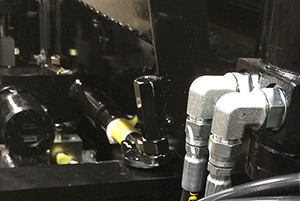
Myth and misapplication are abundant when it comes to hydraulic fitting leaks. To keep yourself and your staff safe, here’s what not to do when you find a hydraulic fitting leak and why.
- Don’t use your hand to check for leaks. Hydraulic fluid can reach temperatures of 300°F or higher, which can cause serious burns. High-velocity leaks can inject fluid through the skin even through gloves, potentially requiring amputation or causing safety violations.
- Don’t just torque (tighten). While a loose nut may cause a leak, over-tightening is a common cause of tube fitting failure. Always assess the connection first.
- Don’t leave the system pressurized. Always depressurize the system before inspection. Note: trapped fluid and back pressure may remain even when the system is off.
- Don’t replace with a different fitting type to save time/money. Always use the exact replacement fitting. Using a similar one may lead to failure and greater long-term costs.
- Don’t always blame the fitting. The source of the leak may not be where fluid is dripping. Fluid can travel before it drips.
- Don’t reuse an O-ring. Always replace O-rings, even in reusable fittings, as cracks can compromise seal integrity.
- Don’t forget to protect an open system while fixing a leak. Dropping components introduces contaminants. Always protect exposed fittings.
- Don’t forget to clean the connecting ends before replacing or reassembling a fitting. Dirt and metal flakes can destroy hydraulic systems.
- No open flames. Mist-like clouds from pinhole leaks can be flammable. Keep flames and ignition sources away.
- Don’t ignore it. Even small leaks may indicate larger issues and should be addressed promptly.
Interested in learning about our hydraulic fittings? Contact us today.